How to identify evergreens: winter desiccation or a pest issue
Learn how to identify if your evergreens have winter desiccation or a pest or disease issue.
I had a request for an article on diagnosing winter desiccation versus pest and disease issues on evergreens. I find diagnosing diseases of evergreens versus physiological and abiotic disorders to be tricky. But here is the decision-making process that I go through. Maybe it's more like a process of elimination…
What species of evergreens are showing symptoms?
Plant identification should always be the first step in any pest management identification issue. Usually when there are more than one species involved, it is more likely an environmental or chemical application or cultural (a.k.a. human element) issue.
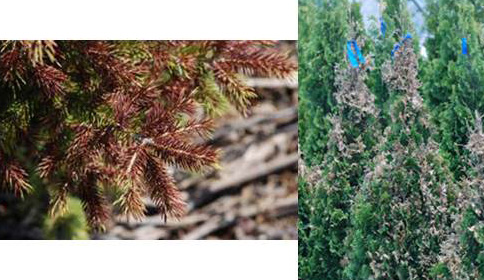
Figure 1: Evergreens showing signs of winter dessication
Where are the symptoms on the tree and is there a pattern?
Many abiotic and environmental issues have some sort of a pattern. Whether its the year(s) of growth that is showing symptoms, the bottom branches vs. the top, the west side of the tree etc. Quite often, winter desiccation is most evident on the SW to NW side of the tree.
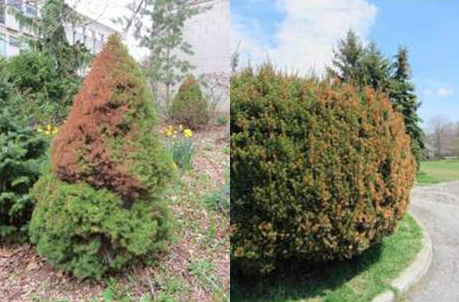
Figure 2: Evergreens showing signs of winter dessication
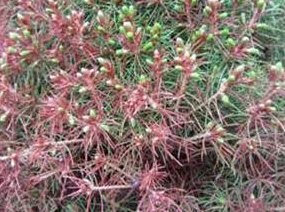
Figure 3: With winter desiccation, the buds will often survive and eventually, mask the lost needles
What % of evergreens in the area are showing symptoms?
Many times, when we see plant symptoms across nearly 100% of the plant species, we can bet that the issue is environmental or physiological, with or without the involvement of human activities. When a smaller % of plants show symptoms, in groups or individually here and there, it could be a pest or disease issue. Not all plants will show the same level of injury, it depends on their genetics, vigor, root system etc.
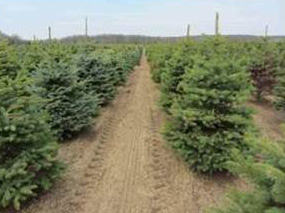
Figure 4: The spruce on the left are doing well, the ones on the right have a lot of winter desiccation. The difference? Seed source.
Are there any signs of disease, such as fruiting structures bursting through the stomates or elsewhere on the needles, any weeping cankers?
Closely examine symptomatic, discoloured needles with your hand lens for fruiting structures or other signs of pathogens. Follow the symptomatic branch all the way to the main stem. If possible, remove it and examine it for cankers or weeping sap. If you can, slice into the bark all the way along the stem to see if there is any brown tissue under the bark……I'm not kidding.
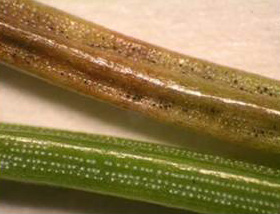
Figure 5 : Top: diseased needle with fruiting structures of Rhizosphaera needlecast bursting out from the stomates. Bottom: healthy needle, green with white stomates from another branch (Photo: Tom Hsiang, University of Guelph)
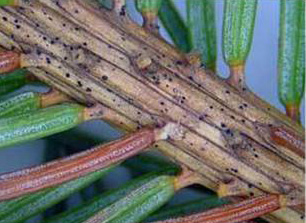
Figure 6: Setomelanomma holmii (black dots) on Spruce twig. The fruiting structures of this fungus on the twig are often associated with spruce decline (needle browning, needle drop) Spruce needle drop is a condition consistently associated with the fungus Setomelanomma holmii. While the pathogenicity of this fungus is still under investigation, it has been reported to cause the discoloration and needle drop of older needles on white spruce (Picea glauca) and Colorado blue spruce (P. pungens) (Source: University of Illinois)
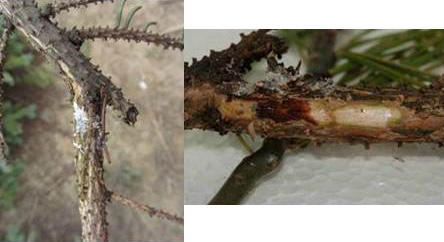
Figure 7: Top left: a small area of weeping sap on the branch of Colorado spruce that was showing signs of decline. Right: when we slice into the area of the weeping, we find dead vascular tissue (reddish brown) bordered by healthy tissue (green and white). Lab diagnosis would be required to identify potential pathogens (e.g. Cytospora, Phomopsis).
Are there any signs of eggs, egg masses, chewed needles on last year's growth?
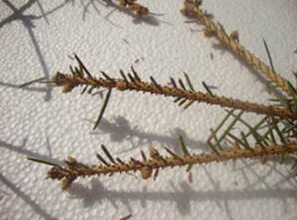
Figure 8: Colorado spruce with half-eaten needles. The most likely culprit was yellow-headed spruce sawfly injury from 2014.
When in doubt, there is always the University of Guelph Pest Diagnostic Clinic.